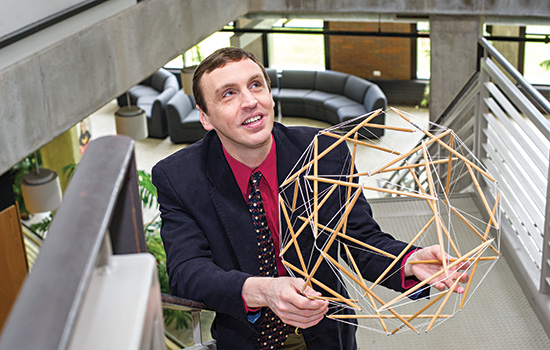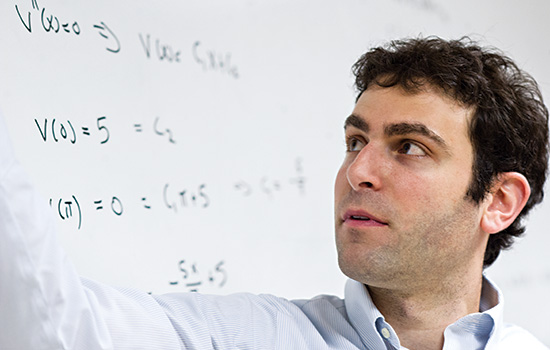New formula for math education
A. Sue Weisler
Applied and computational mathematics graduate student Ben Liu, right, helps student Guangjun Ding during an Introduction to Symbolic Computing class.
Ben Liu is a quantitative problem solver.
Liu has modeled aspects of cells and measured the limits of cardio-electrophysiological models as an undergraduate in RIT’s School of Mathematical Sciences.
His undergraduate research experience prepared him for graduate work with his mentor, RIT professor Elizabeth Cherry, who applies mathematics to understanding electrical signals in the heart.
“I don’t have a biology background, but I find it really enjoyable to be thrust into that world,” says Liu, from Northhampton, Mass. “It think it’s good experience for what a mathematician is expected to do—being able to pick up the salient features of a field to be able to learn enough of it to apply mathematical tools to it.”
Liu, who will graduate in 2014 with his BS/MS in applied and computational mathematics, has benefited from opportunities available to math majors studying at RIT today. His training has taught him to translate aspects of cardio-electrophysiology into the language of math and create formulas that replicate the biological system. The model simulates the system and serves as an isolated test bed for solving problems in that application field.
The evolution of mathematical education at RIT from a department that primarily fulfilled requirements for other majors to a school in the College of Science that offers its students rigorous research experiences like Liu’s began in the 1990s and gained momentum over two decades.
The school was formed in 2006 under then-department head Sophia Maggelakis and, later, gained critical mass with the addition of the Center for Applied and Computational Mathematics and the Center for Computational Relativity and Gravitation. In 2001, a master’s degree program was added.
“It took quite a while for the School of Mathematical Sciences to be where it is today,” says Maggelakis, now dean of the College of Science. “When I started in 1991, the math department was viewed mostly as a service department. And now, with the right investment and hires, we can actually show growth in research and in doing great things in the physical sciences.”
Math and eBay
Jessica Beiter ’13 (BS/MS in applied and computational mathematics) began her studies in 2009. The recent graduate from Lima, N.Y., relocated to Madison, Wis., to take a position with Epic, a software company that serves the health care industry. Beiter’s thesis research grew from an undergraduate project she worked on for eBay to predict referrals to an online marketplace designed for small-business owners selling online coupons.
“I modeled the growth like a virus,” Beiter says. “I used an epidemiology model that I learned about in my math modeling class with Dr. Ross.”
Professor David Ross had suggested the eBay project, which originated with an alumnus at the company. Ross’ industry contacts make him a popular resource for students inquiring about research opportunities, either at RIT or with industry partners.
“When I first came here in 2001, the job of the Department of Mathematics was to teach math courses,” says Ross. “Research now plays a much larger role. In my opinion, that means better teaching. People who are active researchers have fresh examples and endlessly refreshed enthusiasm for the subjects they teach.”
The School of Mathematical Sciences includes the Center for Computational Relativity and Gravitation, led by Manuela Campanelli and Carlos Lousto.
Campanelli, Lousto and Yosef Zlochower joined RIT in 2007, two years after making news as one of the first research teams to simulate the merger of two black holes on a supercomputer, solving the equations for strong field gravity that comprise Einstein’s theory of general relativity, connecting matter, space and time. The Center for Applied and Computational Mathematics, led by associate professor Tony Harkin, also produces high-level research.
“When we formed the center, there were only a handful of us doing applied math modeling and computation, and the growth has been explosive,” Harkin says. “If you want to really understand in science or engineering what’s at the heart of a problem, you have to construct a math model for it. Researchers from many different departments come to see us and say, ‘I’m working on this experiment. Can you help me do some math modeling?’ Word is out that we have the expertise to help others formulate and analyze models and do computer simulations.”
What’s ahead
The School of Mathematical Sciences takes seriously its role in educating students from across the university. It also takes pride in contributing meaningful research.
Maggelakis championed a graduate degree that had been stalled for a decade. The success of the master’s degree has led to the development of a concept paper proposing a doctorate degree with a niche in mathematical modeling. The proposal will need approval from the president, provost, RIT Board of Trustees as well as New York state. The initiative was part of the strategic plan of the school and is reflected in the College of Science’s strategic plan, which was developed and approved in May 2012.
“We needed to show people that we do mathematics and not just teach the entire RIT community the required math courses,” she says. “We need to advance our discipline. We created the School of Mathematical Sciences that houses our academic programs and research centers. When I started as head of the math department we had 33 faculty and when I left the school was comprised of 63 faculty.”
Matt Hoffman, assistant professor in the school, is coordinating the Ph.D. proposal, which will go before the RIT graduate and curriculum committees this fall.
“Students will learn the mathematical and computational tools they will need to construct, analyze and implement models,” Hoffman says. “It fits in really well with things we do here and where we see ourselves going, and is different enough that there’s a reason to do it.”
The strategic growth in the mathematics department continues this fall with the arrival of the new head of the School of Mathematical Sciences, Mihail Barbosu, from The College at Brockport, and six new computational and applied mathematicians, filling retirements and adding support to the proposed Ph.D. program.
“It’s a very active, exciting time to do math modeling at RIT,” Harkin says.
Did you know?
The School of Mathematical Sciences includes:
- Three undergraduate programs: applied mathematics, computational mathematics and applied statistics
- A graduate program in applied and computational mathematics
- The Center for Applied and Computational Mathematics
- The Center for Computational Relativity and Gravitation
- The Summer Math Institute. RIT’s annual industrial mathematics workshop educates high school math teachers about trends in applied mathematics. The school is poised to turn its Summer Math Institute into a national model.
Where do math majors work?
RIT’s math graduates find jobs in a variety of industries, national laboratories and consultancies. On average, 40 to 50 students graduate from the School of Mathematical Sciences each year.
“There is no single trend,” says David Ross, professor in the school. “It’s not as if there is a single company or certain industry that hires the majority of our students. Often, they get a position with some fairly vague name like ‘analyst.’ Some are in math modeling groups. Many are hired as computer programmers who happen to know mathematics.”
Each year, a few graduates join actuaries, banks and financial management firms, such as Capital One and Morgan Stanley, Ross says.
Alumni from the school have made careers in industrial mathematics at Bausch & Lomb, eBay, Google, Harris, Microsoft, Ortho-Clinical Diagnostics, Pictometry, Raytheon and Xerox, for instance.
Many graduates move to the Washington, D.C., area to work at the Census Bureau, the Center for Army Analysis, the Institute for Defense Analyses, the National Geospatial Intelligence Agency, the National Ground Intelligence Center, the National Institutes for Health, the National Security Agency, the Naval Research Laboratory and other national laboratories (variously located) like Argon, Los Alamos and Oak Ridge. Other graduates join consulting firms, such as LMI and Booz Allen Hamilton, which work with governmental agencies.
Computers make the math go round
“Computers are absolutely essential to modern applied math,” says David Ross, professor in the School of Mathematical Sciences. “In my opinion, if you’re going to do math for a living, you’ve got to be good at computer programming.”
Sometimes semantics get in the way. “Computational mathematics” or “scientific computing” sounds confusing to many people outside of the field who associate mathematics with slide rules and calculators, not simulations. Yet, mathematicians have used computers for half a century to solve problems too complicated to compute by hand.
Mathematical modeling and scientific computing are inseparable, says Tony Harkin, associate professor in the school and director of the Center for Applied and Computational Mathematics. The center supports research in fluid mechanics, nonlinear dynamics, image processing, inverse problems, mathematical biology, network analysis, numerical weather prediction and condensed matter.
“Modeling is how you get to the essence of a problem,” Harkin says. “You write down mathematical equations that describe the core attributes of a problem to solve it analytically and computationally. Then you translate those solutions to help inform a real-world business, engineering or scientific application.”
 Tony Harkin, associate professor in the School of Mathematical Sciences, balances a tensegrity structure on his hand. Structures with “tensional integrity” appear in architecture, engineering and biology. A. Sue Weisler
Tony Harkin, associate professor in the School of Mathematical Sciences, balances a tensegrity structure on his hand. Structures with “tensional integrity” appear in architecture, engineering and biology. A. Sue Weisler Matt Hoffman, assistant professor in the School of Mathematical Sciences, leads a class in matrices and boundary value problems. A. Sue Weisler
Matt Hoffman, assistant professor in the School of Mathematical Sciences, leads a class in matrices and boundary value problems. A. Sue Weisler













